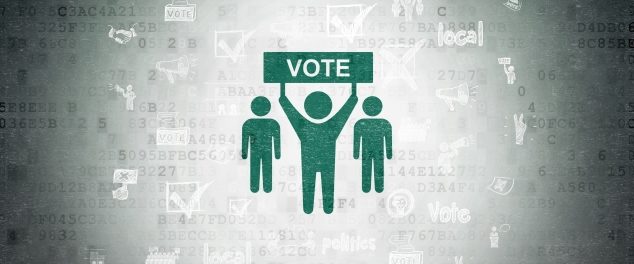Podcast
CA120: Politics in the digital age
 An illustration using hard-drawn images on green data paper. (Maksim Kabakou, via Shutterstock)
An illustration using hard-drawn images on green data paper. (Maksim Kabakou, via Shutterstock)This past election cycle rewrote the rules for digital campaigning.
Most media coverage, especially after the election, has focused on how a brand of digital terrorism – viral campaigns based on fake news stories, fueled by fake social media accounts and hacked computers – put before voters a mix of negative messages and falsehoods that had a huge impact on the U.S. presidential campaign.
In the digital world, Google knows who you are, Amazon knows what you buy, but what campaigns care about is how you vote. And that’s where digital voter file targeting comes in.
This is a massive concern, one that we now know infected the Brexit vote in England and the French presidential election.
But it isn’t exactly above-board activity that is transferable to traditional political campaigns.
The real change for legitimate, rule-abiding political campaigns was more under the radar.
Digital campaigning was quietly transformed from the historic “virtual billboard” kind of targeting — where a candidate buys a banner ad on a local newspaper website and hopes that voters see it — into one that strategically, specifically and directly targeted voters.
This can be thought of as the transition from littering a neighborhood with generic lawn signs to direct mail targeting with messages tailored to each voter.
In the digital world, Google knows who you are, Amazon knows what you buy, but what campaigns care about is how you vote. And that’s where digital voter file targeting comes in. (Ed’s Note: For a discussion of digital campaigning with the author, click here for the Capitol Weekly podcast.)
But, with digital, instead of making precinct walk kits or sending the data to a printer, they send it to a digital match vendor.
Throughout the election cycle this was a means of campaigning that grew significantly, with some campaigns spending 35% or more of their budget on targeted digital.
How it Works
Digital targeting to the voter file begins with the same tools campaigns use to target mailings or precinct walks. And that’s why campaigns love it.
Consultants use their polling and experience to define their targets by vote history, ethnicity, language, age, vote-by-mail status, or income and education levels, among other factors.
A sophisticated campaign will have several sets of targets.
This will include a lot of contact with what we call the “high-propensity, likely persuadable target,” backed up by outreach to their base supporters, including Get Out The Vote (GOTV) efforts aimed at low-propensity voters.
These core targets are often supplemented with several target universes. Those may include a mailing and set of calls to older voters, a specific outreach to millennials, or contacting voters who are likely share the candidate’s position on abortion, education, environment, transportation, taxes, etc.
Campaigns will even craft targets based on those who vote early, followed by a second or third wave aimed at voters who vote late or at the polls.
Digital is run the same way, often with the same multitude of universes.
But, with digital, instead of making precinct walk kits or sending the data to a printer, they send it to an entity known as a digital match vendor.
The data, which began as a targeted universe, is then matched to cookie databases for web search and ad-placement targeting, to Facebook or Twitter for ad promotion, or even matched to mobile IP addresses for the targeting of ads on your hand-held device.
A digital voter contact campaign or geofencing project can start a year before an election.
Digital ads are cheap compared to traditional printed mail pieces. They are less obtrusive than phone calls and they are faster from design to implementation than extensive field programs with weekend-after-weekend of slow progress.
Digital also gives a great feedback loop for campaigns. They can witness the live impact of a Facebook post boosted to a core demographic in their district, and test messages with near-instant results.
One of the newest features is “geofencing,” a method of tracking voters by when they access the internet on their mobile devices, and then writing that information back to the voter file.
This way, voters can be either targeted on their mobile device whenever they are found in a geographic area, or they could get a call about it the following week.
These programs are so relatively cheap they can run for much longer than any other part of the campaign. A digital voter contact campaign or geofencing project can start a year before an election, be pushed to full capacity when voters begin getting their ballots in the mail and stay at full blast all the way through the election.
In fact, many elected officials are continuing a low level of online advocacy to their voters post-election, and preparing to make digital contact with their targeted voters a key part of their constituent outreach.
Not a Panacea
While digital is the fastest growing part of our campaigns, gobbling up millions of dollars in California elections alone last year, it isn’t going to completely end traditional campaigning.
First off, digital matching isn’t perfect – and this feels like the greatest downside of digital targeting.
Going into voter targeting, a campaign might get only a 60%-to-70% digital match to their universe. So, after sending 21,000 voters into a digital match, they might find that there are only 15,000 voters who will actually get the ad.
Essentially, it’s the saturation problem, meaning that campaigns cannot simply target a universe and be sure that all will be hit.
Sure, mail suffers from the “straight to the trashcan” effect, phone calls irritate people and walkers can easily be forgotten by voters. But these traditional means of campaigning at least “feel” like they are attempting to reach all the targeted voters – they aren’t systemically missing voters entirely.
To make this worse, since the data is made anonymous to protect the privacy of those who are being targeted by cookies or IP addresses on their digital devices, campaigns aren’t told which voters are in or out of their ad buy.
It’s not like a phone bank, where you get data back telling you which voters had a bad number, and then you can flag them for door knocking or other outreach. With digital, you’re just told that some didn’t match — and you’re not given a hint of who those voters were.
These are two quick downsides of digital targeting. Essentially, it’s the saturation problem, meaning that campaigns cannot simply target a universe and be sure that all will be hit.
Often a digital firm facing this problem, particularly one without a lot of campaign experience, will attempt to solve this problem by targeting “similars.”
The similars are people who are modeled by sophisticated databases to be just like the target universe. However, this is fools gold for campaigns.
Using similars can destroy the intent of the targeting, robbing the campaign of its ability to use targeted messages repeatedly to a specific set of voters. It’s like taking your mail to Latino homeowner Democrats, and having a firm send that mailer to every house they think would probably have a person who looks like your targeted voter – no matter if they have a vote history, are registered, are even Democratic.
What the future holds
As we get into 2018 we are expecting to see a continued growth in digital targeting. YouTube is getting better at embedding ads to video content, Facebook is looking at more Snapchat-type features that might have commercial opportunities, and even virtual reality devices could someday be infested with a friendly politician or campaign ad.
And if you’re lucky enough to slip through the digital net, there will always be something in your mailbox.
Geotargeting is getting more sophisticated, and we see opportunities for campaigns to “geofence” an area, like a public school or community college, and then using that data to drive ads for a local education bond measure, or geofencing all sports venues in the state for a ballot measure funding a new sports stadium in your city.
Campaigns are becoming more comfortable with highly targeted digital contact, and they are getting a sense of how to use digital to compliment traditional voter outreach knowing that digital alone cannot supplant all campaign outreach.
As we get into 2018, expect to see more targeted ads in your browser or on your smart phone. Campaigns are going to know who you are, where you are, and what means by which they can get to you.
And if you’re lucky enough to slip through the digital net, there will always be something in your mailbox.
—
Ed’s Note: Paul Mitchell, a veteran political strategist and a regular contributor to Capitol Weekly, is the founder of the CA120 column and the vice president of Political Data, which markets information to campaigns in both major parties.
Want to see more stories like this? Sign up for The Roundup, the free daily newsletter about California politics from the editors of Capitol Weekly. Stay up to date on the news you need to know.
Sign up below, then look for a confirmation email in your inbox.

Leave a Reply